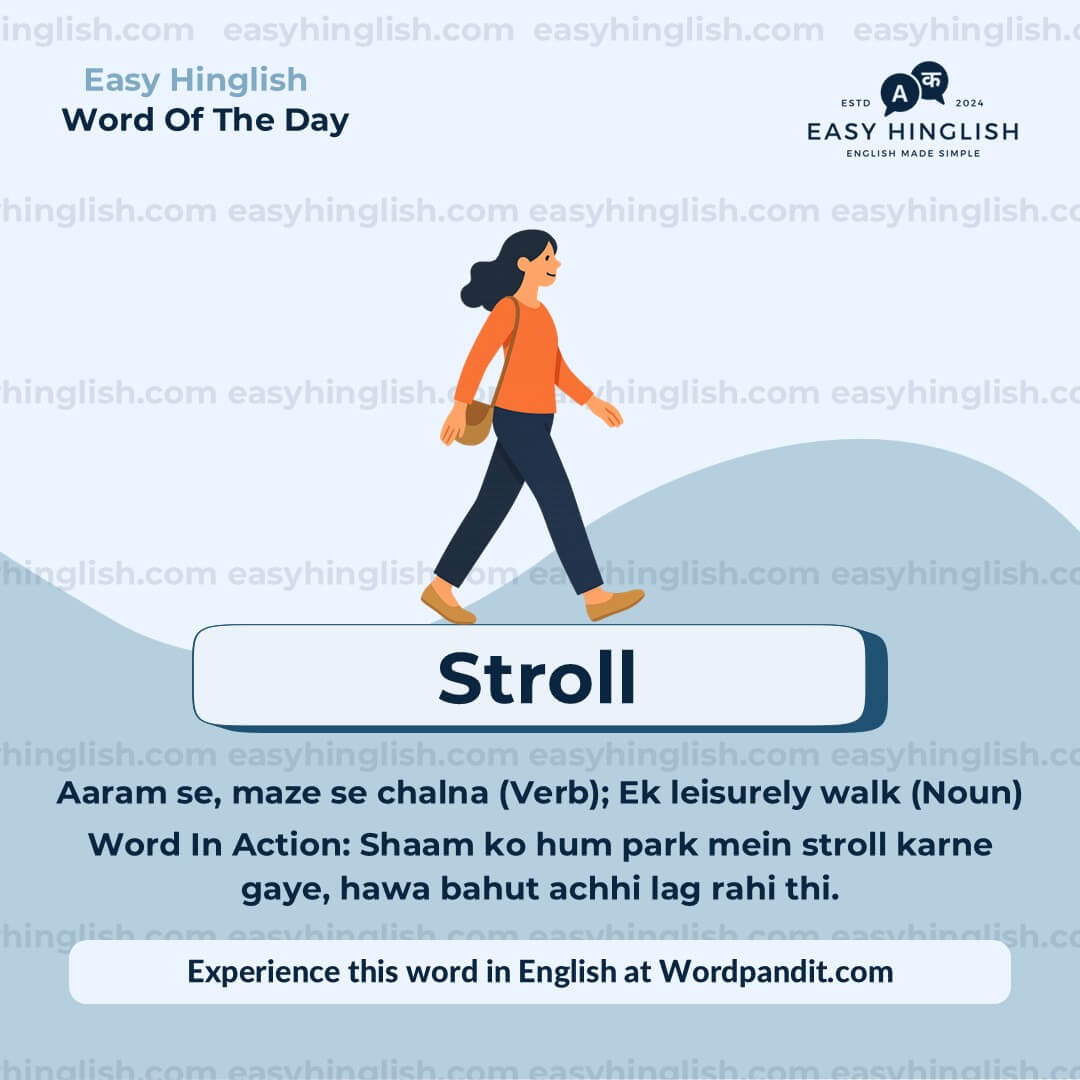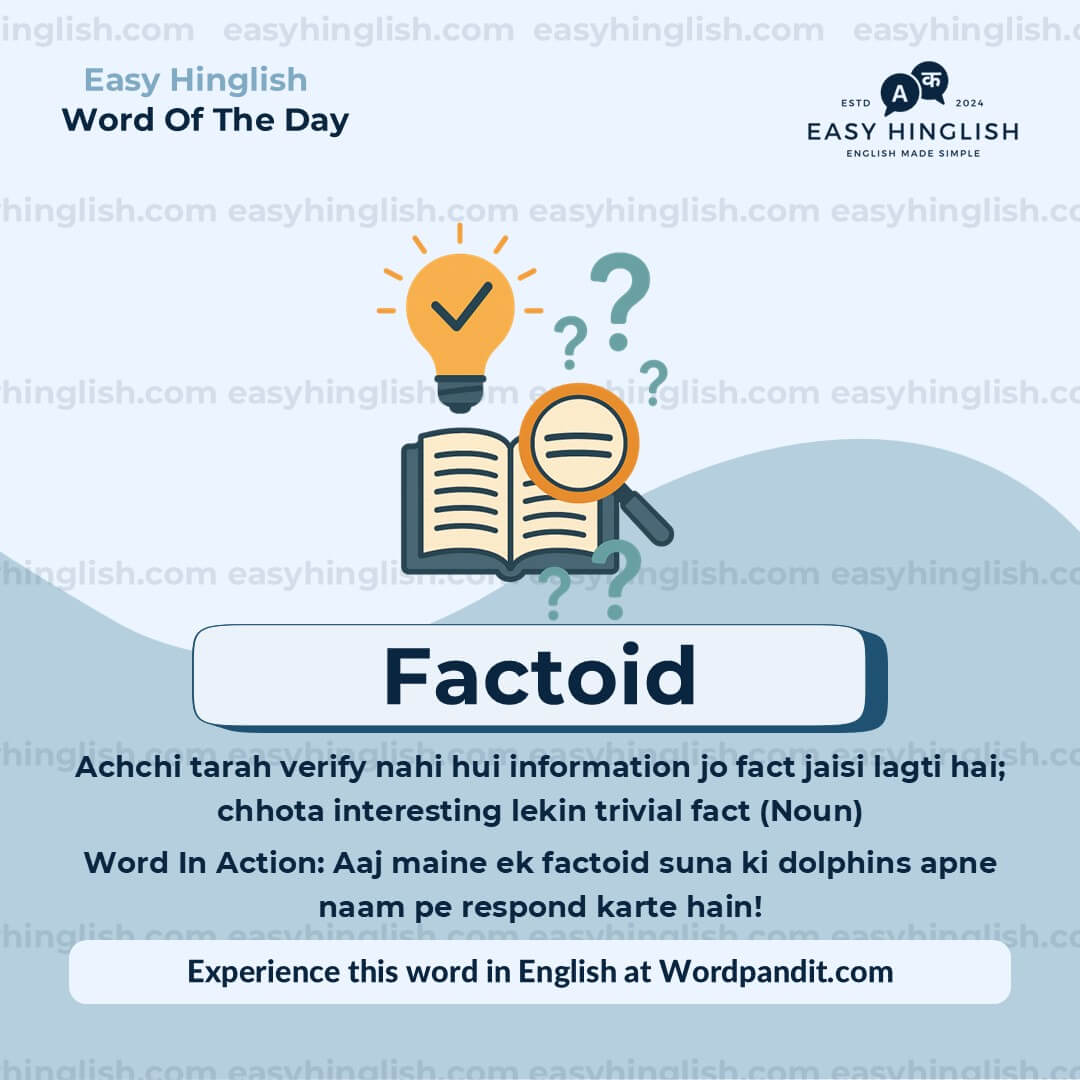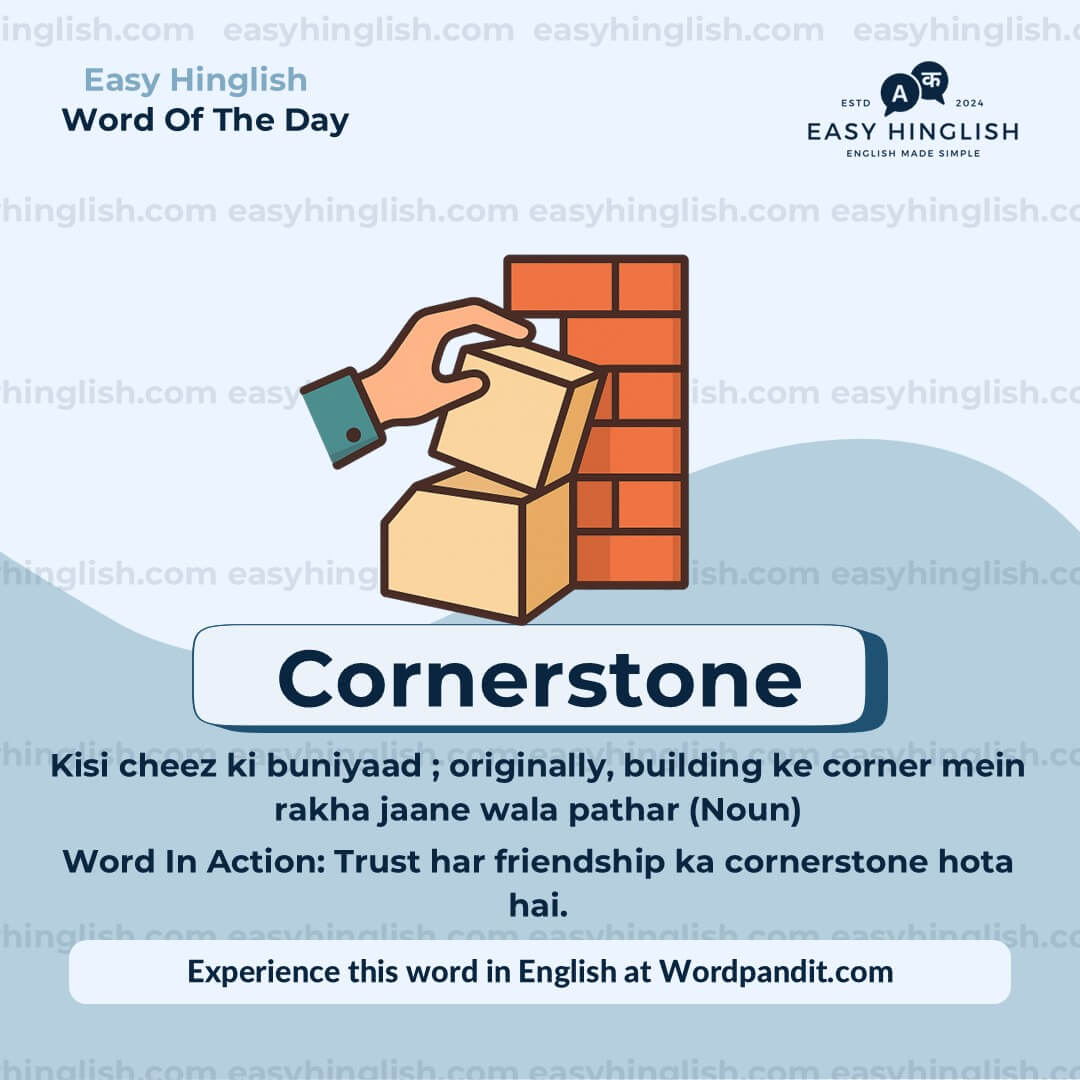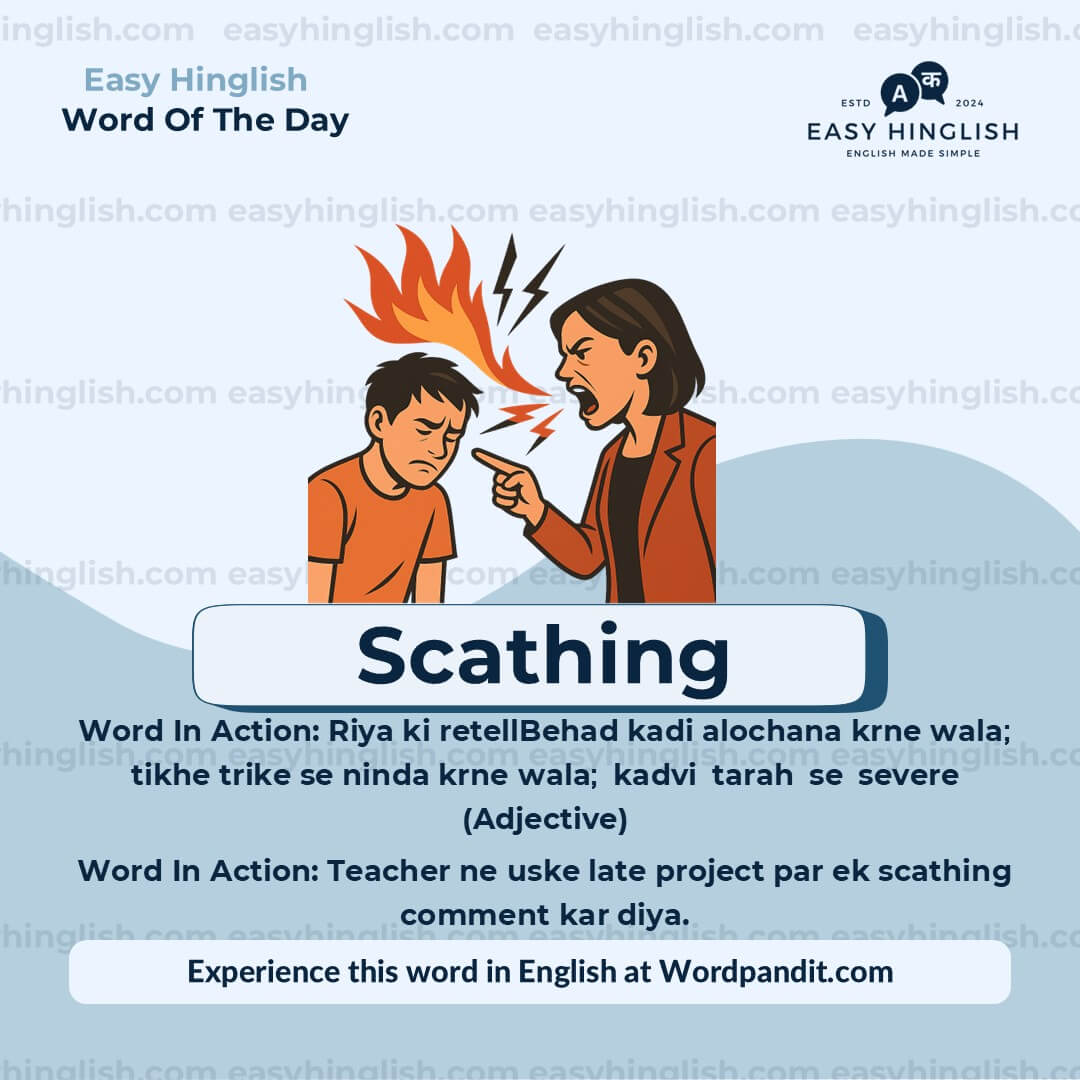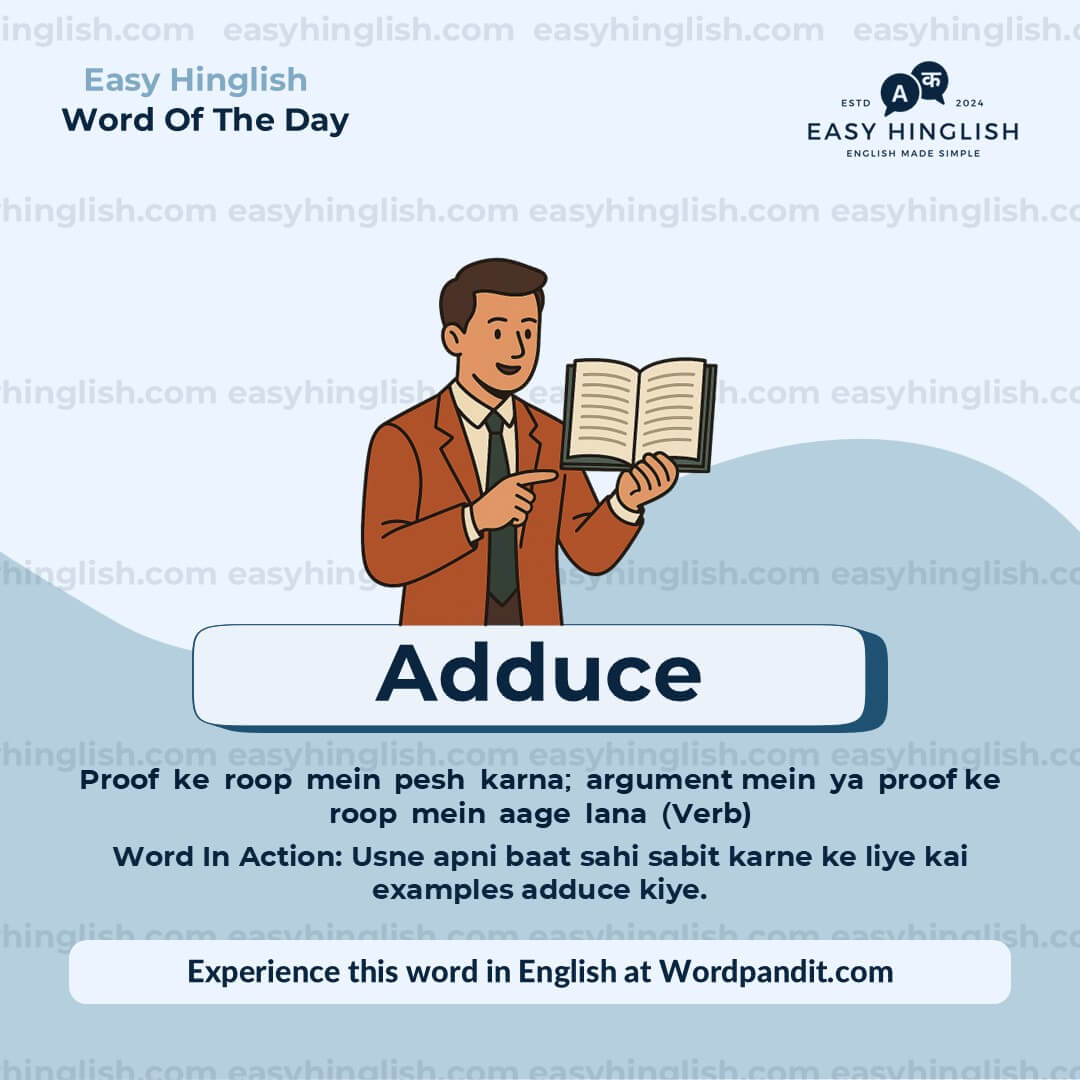Daily Vocabulary Indian Newspapers aur Publications se Seekho
Welcome to Wordpandit ka Indian Vocabulary Hub
Wordpandit par, hum samajhte hain ki ek achhi vocabulary develop karne ke liye local context samajhna bhi zaroori hai. Is section ka focus hai aapke vocabulary ko India ke leading newspapers aur publications se naye shabdon aur phrases ke zariye improve karna, taaki aap practical, relevant, aur uniquely Indian words seekh sakein.
Indian Sources Itne Important Kyun Hain?
Hum maante hain ki kisi bhi language ko sikhne ka sabse best tareeka hai uske local content me immerse hona. Isi wajah se hum carefully words curate karte hain top Indian newspapers aur publications se, jaise:
- The Hindu
- The Times of India
- The Economic Times
- Hindustan Times
- Live Mint
- The Indian Express
- Aur bhi bahut saare...
Hamesha Updated Raho, Hamesha Relevant Raho
Daily updates ke saath, aap Indian news sources se naye words seekhoge jo Indian society aur culture ke latest trends ko reflect karte hain. Hamara focus hai aise words provide karna jo aapke liye real-world me useful ho.
Wordpandit Aapke Learning Goals Ko Kaise Support Karta Hai?
Chahe aap exams ki preparation kar rahe ho, professional communication improve karna chahte ho, ya sirf naye words seekhna chahte ho, Wordpandit har step par aapki madad karega.
Practical Tareeke Se Seekho
Hamari interactive learning methodology me real-world examples, engaging activities, aur context-based usage shamil hain, taaki har naya shabd aapki active vocabulary ka hissa ban sake.
Aaj Hi Indian Vocabulary Seekhna Shuru Karo!
Wordpandit Kyun Choose Karein?
Practical Learning: Aise words seekho jo aapko real-world reading aur communication me sach me kaam aayenge, taaki aapki comprehension aur bolne ki skills improve ho.
Diverse Content: Current affairs se lekar scientific breakthroughs tak, hamare different sources aapko multiple domains ka vocabulary sikhate hain.
Effortless Integration: Wordpandit ko apni daily routine ka part banao. Sirf kuch minute har din dene se aapki vocabulary time ke saath kaafi improve ho sakti hai.
Aapka Vocabulary Mastery Tak Ka Safar
- Regularly hamare Daily Vocabulary section ko visit karo
- Naye words explore karo aur unka context me use samjho
- In words ko apni writing aur bolne ki practice me use karne ki koshish karo
- Jaise-jaise aapke words badhte hain, apni progress ko track karo
Aaj Se Apni Vocabulary Journey Shuru Karo!
Wordpandit ke saath vocabulary improve karna start karo. Roz thoda effort dalne se aap ek strong vocabulary develop kar sakte ho jo academic, professional, aur personal life me kaafi kaam aayegi.
Yaad rakho, ek naya shabd roz seekhna linguistic limitations ko door karne ka best tareeka hai! Wordpandit ko apni daily learning journey ka sathi banao aur vocabulary excellence ki taraf badho!
WORD-1: Stroll
Sandarbh (Context):
"He was seen taking a stroll around the campus before heading to the auditorium for the convocation ceremony." - The Indian Express
Vyakhya (Explanatory Paragraph):
Stroll ka matlab hai 'aaram se, dhire-dhire chalna jab aapko jaldi nahi hai aur koi specific destination bhi nahi hai.' Yeh word tab use hota hai jab aap describe kar rahe ho ki koi relaxed tarike se walk kar raha hai, mazze ke liye ya aaram karne ke liye, na ki kisi jagah jaldi pahunchne ke liye. Stroll ka upyog descriptive writing, travel articles aur everyday conversation mein hota hai jab peaceful aur casual movement dikhani ho. Competitive exam passages, newspapers aur lifestyle articles mein stroll commonly use karte hain jab stress-free, leisurely walking ke baare mein baat karni hoti hai.
Arth (Meaning): Aaram se, maze se chalna (Verb); Ek leisurely walk (Noun)
Uccharan (Pronunciation): STROHL (स्ट्रोल)
Kathinai Star (Difficulty Level): ⭐ Basic
Utpatti (Etymology): Stroll German word 'strolchen' se aaya hai jiska matlab hai 'ghumna ya bhatakna.' Yeh 17th century mein English mein aaya jab traveling performers aur wanderers ek sheher se doosre sheher ghoomte the. Time ke saath, yeh word aimless wandering se evolve karke pleasant, leisurely walking ka symbol ban gaya jo log mazze ke liye karte hain, zaroorat se nahi.
Prashant Sir Ke Tathya (Prashant Sir's Notes):
Bahut students stroll ko walk se confuse karte hain—dono mein paidal chalna hai, lekin stroll ka sahi istemal kaise karein yeh samajhna zaroori hai. Stroll aur walk mein kya farak hai? 'Walk' neutral hai pace aur purpose ke baare mein, jabki 'stroll' hamesha leisure aur no urgency suggest karta hai. CAT aur IELTS ke students ke liye, passages mein 'stroll' identify karna help karta hai calm atmosphere ya character ki relaxed state of mind pehchanne mein. Indian newspapers mein aapko aksar "evening stroll at Marine Drive" ya "strolling through Lodhi Garden" milega—yeh recreational, stress-free activities indicate karte hain, na ki purposeful movement. Exam RC passages mein jab character 'strolling' kar raha hota hai, toh author peaceful, contemplative mood create kar raha hota hai.
Samanarthi & Vipritarthi (Synonyms & Antonyms):
Samanarthi (Synonyms): saunter, amble, wander, ramble, meander, promenade, aaram se chalna, tehalna, ghoomna-phirna, walk leisurely
Vipritarthi (Antonyms): rush, hurry, dash, sprint, run, bhaagna, jaldi karna
Udaharan (Usage Examples):
- Har Sunday subah, Sharma ji Juhu Beach par stroll karte hain taaki busy week shuru hone se pehle apna mind clear kar sakein.
- Dinner ke baad couple ne Connaught Place mein stroll karne ka decide kiya, Delhi ki thandi shaam enjoy karte hue aur window shopping karte hue.
- UPSC exam ke liye ghanto ki intense padhai ke baad, Priya ko laga ki neighborhood mein thoda stroll karne se uski concentration refresh ho jaati hai.
- Jaipur Literature Festival mein, visitors book stalls aur discussion venues ke beech stroll karte hain, bina kisi fixed schedule ke literary atmosphere enjoy karte hue.
Sanskritik Sandarbh (Cultural Reference):
"Shah Rukh Khan ki iconic film 'Dilwale Dulhania Le Jayenge' mein, Raj aur Simran ki romantic relationship Punjab ke sarson ke khet mein leisurely strolls ke dauran blossom hoti hai—yeh dikhata hai ki strolling freedom, peace aur unhurried connection represent karta hai." - Classic Bollywood cinema
Sochiye (Think About It):
Hamare fast-paced urban lives mein jahan sabhi ek jagah se doosri jagah bhaag rahe hain, aapne last time kab genuine stroll kiya tha bina phone check kiye ya time ki chinta kiye?
Chhoti Kriya (Quick Activity):
Apne sheher mein apni favorite strolling jagah describe karein. Do sentences likhein explaining kyon woh location leisurely walking ke liye perfect hai aur aapko wahan stroll karte hue kya sabse zyada pasand aata hai.
Yaad Karne Ka Tarika (Memory Tip):
'Stroll' ko aise yaad rakhein: 'S-TROLL'—imagine karo ek slow troll (fairy tales waala) jo kabhi jaldi nahi karta aur hamesha relaxed, leisurely pace se chalta hai. Jaise trolls stories mein forests mein slow chalte hain, waise hi aap parks ya streets mein slowly stroll karte ho.
Vastavik Jeevan Me Upyog (Real-World Application):
Stroll commonly travel writing, lifestyle articles aur descriptive essays mein use hota hai ek calm, peaceful atmosphere create karne ke liye. Business communication mein, phrases jaise "let's stroll through the agenda" metaphorically relaxed, unhurried approach suggest karte hain topics review karne ka. Competitive exam essays ke liye, sirf 'walk' ki jagah 'stroll' use karna descriptive richness add karta hai aur vocabulary range dikhata hai. Journalists iska use karte hain jab politicians, celebrities ya public figures ko describe karna ho jo casually public spaces mein move kar rahe hain, unki relaxed movement ko formal processions ya rushed entries se distinguish karne ke liye.
WORD-2: Factoid
Sandarbh (Context):
"A frequently repeated factoid is that…" - The Indian Express
Vyakhya (Explanatory Paragraph):
Factoid ka matlab hai 'ek chhoti si information jo fact ki tarah present ki jaati hai lekin actually verify nahi hui ya galat ho sakti hai, ya phir koi interesting lekin trivial fact.' Yeh word tab use hota hai jab bite-sized information media, social networks aur WhatsApp forwards mein rapidly spread hoti hai chahe uski accuracy questionable ho ya nahi. Factoid ka upyog journalism, academic writing aur media criticism mein hota hai jab verified facts aur popularly believed but unverified information ke beech difference dikhana ho. CAT, GRE aur UPSC ke passages mein factoid commonly signal karta hai ki author widely circulated claims par skepticism express kar raha hai.
Arth (Meaning): Achchi tarah verify nahi hui information jo fact jaisi lagti hai; chhota interesting lekin trivial fact (Noun)
Uccharan (Pronunciation): FAK-toyd (फैक्टॉयड)
Kathinai Star (Difficulty Level): ⭐⭐ Basic se Intermediate
Utpatti (Etymology): Factoid word 1973 mein American author Norman Mailer ne create kiya tha, jinhone 'fact' aur suffix '-oid' (jiska matlab hai 'jaisa dikhta hai lekin genuine nahi') ko combine kiya. Mailer ka original intention tha "facts jo newspaper ya magazine mein aane se pehle exist hi nahi karte the." Ironically, yeh word khud ek factoid ban gaya—iska meaning popular usage mein evolve hokar trivial but true facts ko bhi include karne laga, jo Mailer ke original intent ke opposite hai. Yeh dikhata hai ki language widespread use ke through kaise transform hoti hai.
Prashant Sir Ke Tathya (Prashant Sir's Notes):
Bahut students factoid ko fact se confuse karte hain—factoid aur fact mein kya farak hai? Crucial difference yeh hai ki factoid ya to questionable hota hai ya trivial, jabki fact verified aur substantial hota hai. Students aksar poochhte hain: factoid aur trivia mein difference kya hai? Trivia unimportant lekin true information hoti hai, jabki factoid ka usage specifically authenticity ke baare mein doubt carry karta hai. CAT aur GRE ke students ke liye, jab aap RC passages mein 'factoid' dekhte ho, usually yeh author ki skepticism signal kar raha hai commonly believed information ke baare mein. Indian newspapers aur WhatsApp forwards mein factoids rapidly spread hote hain—claims jaise "hum apne brain ka sirf 10% use karte hain" ya "Gandhi ji ko kabhi Nobel Peace Prize nahi mila" classic factoids hain jo truth ko misconception ke saath mix karte hain. Competitive exams mein factoid ka sahi istemal kaise karein: iska use tab karein jab aap popular beliefs ya unverified claims ko challenge karna chahte ho.
Samanarthi & Vipritarthi (Synonyms & Antonyms):
Samanarthi (Synonyms): myth, misconception, urban legend, half-truth, misinformation, trivia (modern usage mein), tidbit, snippet, rumor, pseudo-fact, अधूरी सच्चाई, अफवाह
Vipritarthi (Antonyms): fact, truth, reality, verified information, established fact, substantiated claim, सत्य, प्रमाणित जानकारी
Udaharan (Usage Examples):
- WhatsApp par widely circulated factoid ki Taj Mahal originally ek Shiva temple tha, historical evidence ke bina viral hota rehta hai aur communal tensions create karta hai.
- Election campaign ke dauran, social media factoids se flood ho gaya tha jo candidates ke baare mein voters ko mislead karne ke liye design kiye gaye the instead of inform karne ke.
- Priya ki presentation Bollywood ke interesting factoids se bhari thi—jaise "Amitabh Bachchan voice rejected thi radio ke liye"—lekin yeh trivial information actual business proposal mein koi value add nahi kar rahi thi.
- COVID-19 pandemic ke dauran, yeh dangerous factoid ki garam paani peene se virus mar jaata hai, public health officials ko baar baar debunk karna pada kyunki log isse believe kar rahe the.
Sanskritik Sandarbh (Cultural Reference):
"Indian cricket commentary factoids se bhari rehti hai—jaise 'Sachin Tendulkar ne jersey number 10 isliye choose kiya kyunki woh 10th month mein paida hue the'—bahut si aise claims convincing lagti hain lekin often verification ki kami hoti hai ya complex stories ke simplified versions hote hain." - Common cricket trivia
Sochiye (Think About It):
Aapne kitne factoids jo social media ya WhatsApp forwards se seekhe, unhe bina verify kiye share kar diye hain? Isse kya pata chalta hai ki digital age mein misinformation kaise spread hoti hai aur humari responsibility kya hai?
Chhoti Kriya (Quick Activity):
Kisi ek popular factoid ke baare mein sochiye jo aapne Indian history, science, ya culture ke baare mein suna hai. Do sentences likhiye explaining ki woh kyun questionable ho sakta hai aur aap kaise verify kar sakte hain ki woh actually true hai ya nahi. Example: "Shampoo word Hindi 'champo' se aaya hai" ya "Great Wall of China space se dikhti hai."
Yaad Karne Ka Tarika (Memory Tip):
'Factoid' ko tod ke yaad rakhein: 'FACT + VOID'—imagine karo ek fact jiske andar void ya khaalipan hai, matlab bahar se fact jaisa dikhta hai lekin andar koi solid truth nahi hai. Ya socho '-oid' jaise 'android' mein (human jaisa lekin human nahi)—factoid fact-jaisa hai lekin real fact nahi. Ek aur tarika: FAK-TOYD = FAKE TOY—jaise toy gun asli gun nahi hoti, waise factoid asli fact nahi hota, sirf fact jaisa dikhta hai.
Vastavik Jeevan Me Upyog (Real-World Application):
Factoid commonly media criticism, academic writing aur journalistic analysis mein use hota hai unverified claims ko challenge karne ke liye jo widely circulate hote hain. Competitive exam essays mein—especially misinformation, social media ya digital literacy par likhte waqt—'factoid' ka use sophisticated vocabulary aur critical thinking demonstrate karta hai. News editors yeh term use karte hain jab fact-checking protocols discuss karte hain aur verified reporting ko viral claims se distinguish karte hain. UPSC aspirants ke liye governance aur public policy par likhte waqt 'factoid' valuable hai jab discuss karna ho ki misconceptions kaise public opinion aur policy debates ko influence karte hain. Corporate communication mein informed professionals iska use warning dene ke liye karte hain ki unverified market rumors ya industry gossip par decisions base na karein.
WORD-3: Cornerstone
Sandarbh (Context):
"Education is the cornerstone of a nation's progress." - The Indian Express
Vyakhya (Explanatory Paragraph):
Cornerstone ka matlab hai 'kisi cheez ka sabse fundamental ya essential element jis par poori structure depend karti hai; kisi system ka sabse important part.' Yeh word tab use hota hai jab foundational principle, value ya component ko describe karna ho jo kisi badi cheez ke existence ya success ke liye crucial hai. Cornerstone ka upyog kab hota hai—formal speeches, policy documents aur academic writing mein jab kisi particular element ki critical importance emphasize karni ho. CAT, GRE aur UPSC ke essays aur passages mein cornerstone commonly signal karta hai ki author kis element ko indispensable foundation maan raha hai systems, organizations ya ideologies ka.
Arth (Meaning): Kisi cheez ki buniyaad ; originally, building ke corner mein rakha jaane wala pathar (Noun)
Uccharan (Pronunciation): KOR-ner-stohn (कॉर्नरस्टोन)
Kathinai Star (Difficulty Level): ⭐⭐ Basic se Intermediate
Utpatti (Etymology): Cornerstone literal architectural practice se aaya hai jahan building ke foundation ke corner mein ek specially important stone rakha jata tha jo do walls ko join karta tha aur significant structural weight bear karta tha. Yeh practice ancient construction methods se hai—biblical times aur classical architecture mein common tha. Term religious texts mein appear hota hai aur gradually metaphor ban gaya kisi bhi foundational ya essential element ke liye. 16th century tak, 'cornerstone' ka figurative use English mein common ho gaya tha institutions, beliefs aur systems ke fundamental principles ya indispensable components describe karne ke liye.
Prashant Sir Ke Tathya (Prashant Sir's Notes):
Bahut students cornerstone ko foundation se confuse karte hain—cornerstone aur foundation mein kya farak hai? Dono basics se related hain, lekin foundation entire base hoti hai jabki cornerstone single most critical element hai. Students aksar poochhte hain: cornerstone aur pillar mein difference kya hai? Pillar andar se support karta hai, lekin cornerstone ka usage specifically emphasize karta hai wo joining, stabilizing element jo multiple parts ko together hold karta hai. UPSC aur CAT ke students ke liye, passages mein 'cornerstone' recognize karna—especially policy, governance ya business contexts mein—help karta hai identify karne mein ki author kise absolutely essential consider kar raha hai. Indian newspapers mein aapko frequently phrases milenge jaise "the cornerstone of India's foreign policy" ya "transparency is the cornerstone of good governance"—yeh signal karte hain non-negotiable, fundamental principles. Competitive exams ke liye cornerstone ka sahi istemal kaise karein: iska use tab karein jab aap complex arguments mein importance ki hierarchy establish karna chahte ho.
Samanarthi & Vipritarthi (Synonyms & Antonyms):
Samanarthi (Synonyms): foundation, bedrock, basis, keystone, linchpin, mainstay, pillar, backbone, anchor, fundamental, essential element, core principle, बुनियाद, आधार, नींव
Vipritarthi (Antonyms): accessory, addition, supplement, optional element, peripheral aspect, non-essential, afterthought, गैर-ज़रूरी, अतिरिक्त
Udaharan (Usage Examples):
- Indian Constitution hamari democracy ka cornerstone hai jo saat dashkon se saare laws ko guide karta hai aur fundamental rights protect karta hai—iske bina democratic structure collapse ho jayega.
- Mutual trust kisi bhi successful business partnership ka cornerstone hai, especially Indian family-run enterprises mein jahan relationships contracts se zyada matter karti hain.
- Infosys founder Narayana Murthy ke liye, integrity hamesha se company ki culture aur operational philosophy ka cornerstone raha hai—yeh ek value hai jo compromise nahi ki ja sakti.
- National Education Policy 2020 multilingualism ko cognitive development aur cultural preservation ka cornerstone identify karti hai Indian schools mein, recognizing ki language diversity India ki strength hai.
Sanskritik Sandarbh (Cultural Reference):
"Mahatma Gandhi ki philosophy mein, non-violence (ahimsa) sirf ek tactic nahi thi balki unki entire approach to social aur political change ka cornerstone tha—yeh principle worldwide civil rights movements ko inspire karta raha aur aaj bhi India ke constitutional values ke केंद्र mein hai." - Gandhian philosophy
Sochiye (Think About It):
Agar aapko ek cornerstone value ya principle identify karna ho jo aapki personal ya professional life ko guide karta hai, to woh kya hoga, aur woh aapke daily decisions ko kaise influence karta hai? Kya aap us principle ke bina imagine kar sakte hain apni life ko?
Chhoti Kriya (Quick Activity):
Koi ek institution choose kariye jo aap acche se jaante hain—aapka college, workplace, ya koi famous Indian company jaise Tata Group, ISRO, ya IIT. Do sentences likhiye explaining ki aapke hisaab se uski success ya identity ka cornerstone kya hai, aur kyun us element ko remove karne se organization fundamentally change ho jayega.
Yaad Karne Ka Tarika (Memory Tip):
'Cornerstone' ko literally socho as the stone at the CORNER of a building—yeh wahan hota hai jahan do walls meet karti hain aur entire structure ko together hold karta hai. Jaise cricket team se cornerstone player jaise Virat Kohli ya MS Dhoni ko remove karne se entire team ki foundation hil jaati hai, waise hi cornerstone woh essential element hai jise aap remove nahi kar sakte without everything collapsing. CORNER + STONE = जहां दो दीवारें मिलती हैं वहां का पत्थर = सबसे ज़रूरी चीज़।
Vastavik Jeevan Me Upyog (Real-World Application):
Cornerstone commonly policy documents, mission statements aur strategic plans mein use hota hai core principles identify karne ke liye jo compromise nahi kiye ja sakte. Academic writing aur UPSC essays mein 'cornerstone' ka use demonstrate karta hai ki aap complex systems ke fundamental elements identify aur articulate kar sakte hain—chahe democratic values discuss kar rahe ho, economic policies, ya social reforms. Business leaders yeh term vision statements mein use karte hain non-negotiable values communicate karne ke liye. GRE aur CAT aspirants ke liye, RC passages mein 'cornerstone' recognize karna help karta hai author ki main thesis ya central argument identify karne mein jis par sab kuch depend karta hai. Journalists iska use political platforms, constitutional principles ya institutional reforms analyze karte waqt karte hain highlight karne ke liye ki kya truly essential hai versus kya merely supportive hai.
WORD-4: Scathing
Sandarbh (Context):
"The journalist wrote a scathing article about the corruption…" - The Times of India
Vyakhya (Explanatory Paragraph):
Scathing ka matlab hai 'bahut hi तीखी aur harsh criticism jo harm ya damage cause kare; devastatingly severe judgment.' Yeh word tab use hota hai jab criticism sirf negative nahi balki devastatingly sharp ho aur kisi ki reputation ya position ko damage karne ke liye intended ho. Scathing kaise use karte hain—book reviews, political commentary aur journalistic writing mein jahan strong disapproval express karna zaroori ho. CAT, GRE aur UPSC ke passages aur opinion pieces mein scathing commonly dikhta hai jab fierce, cutting aur unsparing intensity ki criticism describe karni ho—yeh ordinary criticism se kahin zyada powerful hota hai.
Arth (Meaning): Behad kadi alochana krne wala; tikhe trike se ninda krne wala; kadvi tarah se severe (Adjective)
Uccharan (Pronunciation): SKAY-thing (स्केथिंग)
Kathinai Star (Difficulty Level): ⭐⭐⭐ Intermediate
Utpatti (Etymology): Scathing Old Norse word 'skaða' se aaya hai jiska matlab tha 'hurt ya injure karna,' jo Middle English 'scathen' mein evolve hua. Originally, iska literal meaning tha physically burn, scorch ya harm karna. 16th century tak, word ne apna metaphorical meaning le liya—words ke through damage inflict karna rather than fire se—yeh capture karta hai ki harsh criticism utni hi severely burn aur wound kar sakti hai jitna physical flames. '-ing' form emphasize karta hai is verbal assault ki ongoing, active nature ko—jaise aag continuously जलाती है, waise scathing criticism continuously नुकसान पहुंचाती है.
Prashant Sir Ke Tathya (Prashant Sir's Notes):
Bahut students scathing ko critical se confuse karte hain—scathing aur critical mein kya farak hai? Dono negative judgment involve karte hain, lekin scathing ka usage specifically extreme harshness aur intent to damage imply karta hai. Scathing aur harsh mein difference yeh hai ki 'harsh' unintentionally severe ho sakta hai, lekin 'scathing' hamesha deliberate, cutting intensity carry karta hai—yeh calculated attack hai. CAT aur GRE ke students ke liye, jab aap RC passages mein 'scathing review' ya 'scathing critique' dekhte ho, yeh strongest possible negative evaluation signal karta hai—yeh author tone aur attitude questions mein madad karta hai. Indian English journalism mein aapko frequently phrases milenge jaise "the opposition delivered a scathing attack on the government's economic policy" ya "the film received scathing reviews from critics"—word ordinary criticism ko devastating condemnation mein elevate kar deta hai. Competitive exams ke liye scathing ka sahi istemal kaise karein: tone-based questions mein differentiate karein mild disapproval, criticism, aur absolute demolition ke beech.
Samanarthi & Vipritarthi (Synonyms & Antonyms):
Samanarthi (Synonyms): harsh, severe, biting, caustic, scornful, withering, devastating, brutal, cutting, savage, vitriolic, acerbic, fierce, excoriating, कड़ी निंदा, तीखा
Vipritarthi (Antonyms): complimentary, praising, gentle, mild, laudatory, appreciative, favorable, kind, supportive, प्रशंसात्मक, सौम्य
Udaharan (Usage Examples):
- Supreme Court ne state government ke pandemic handling par scathing judgment diya, unki preparedness aur transparency ko har level par question karte hue—yeh sirf criticism nahi, complete condemnation tha.
- Test series mein disastrous performance ke baad, cricket captain ko former players aur commentators se Indian sports media across scathing criticism face karni padi jo unki captaincy decisions ko brutally question kar rahi thi.
- Arundhati Roy ki India mein social inequality par scathing commentary ne unhe literary circles mein ek celebrated voice bhi banaya aur controversial figure bhi—unke harsh words ignore nahi kiye ja sakte.
- Auditor ki scathing report ne company mein massive financial irregularities reveal kiye, jiske result mein teen senior executives ka immediate resignation हुआ aur media mein तूफान आ gaya.
Sanskritik Sandarbh (Cultural Reference):
"Film critic Rajeev Masand apni scathing reviews ke liye jaane jaate hain poorly made Bollywood films ki—unki zero-star ratings aur witty takedowns legendary ban chuki hain, filmmakers unse darte bhi hain aur respect bhi karte hain kyunki unki brutally honest assessments box office collections ko significantly impact kar sakti hain." - Indian film criticism
Sochiye (Think About It):
Scathing criticism kab justified hoti hai, aur kab yeh necessary accountability se personal attack ki line cross kar jati hai? Hum honest evaluation aur human dignity ke liye respect ke beech kaise balance banaye? Kya public figures ko zyada scathing criticism face karni chahiye ya sabko equal standards apply hone chahiye?
Chhoti Kriya (Quick Activity):
Kisi recent public controversy ke baare mein sochiye jahan kisi ko media mein scathing criticism mili ho—political leader, celebrity, ya corporate executive. Do sentences likhiye explaining ki kya aapko lagta hai criticism justified thi aur aise harsh public condemnation ka kya impact ho sakta hai person aur society par.
Yaad Karne Ka Tarika (Memory Tip):
'Scathing' ko 'SCALDING' se connect karke yaad rakhein—dono 'SCA' se start hote hain aur dono burning involve karte hain. Jaise scalding water aapki skin ko painfully जलाता hai, waise scathing criticism kisi ki reputation ya feelings ko harsh words se जलाती hai. Imagine karo ek journalist ke words उतने गर्म hain जितना boiling water, criticize किए जा रहे person को scald कर रहे hain. SCATHING = SCALDING CRITICISM—दोनों में जलन होती है!
Vastavik Jeevan Me Upyog (Real-World Application):
Scathing commonly film reviews, book critiques, political commentary aur investigative journalism mein use hota hai disapproval ki intensity convey karne ke liye. Competitive exam essays mein—especially media ethics ya freedom of expression par—'scathing' ka use nuanced understanding demonstrate karta hai criticism levels ki. UPSC aspirants ke liye governance aur accountability par likhte waqt, yeh term valuable hai jab judicial pronouncements, CAG reports, ya parliamentary debates discuss karna ho jahan harsh criticism democratic oversight serve karti hai. Business journalists 'scathing' use karte hain jab damaging analyst reports, shareholder critiques, ya regulatory findings report kar rahe hon. GRE aur CAT reading comprehension mein, 'scathing' recognize karna help karta hai accurately answer karne mein tone aur attitude questions, distinguishing karte hue merely critical aur devastatingly harsh authorial stances ke beech—yeh competitive exams mein crucial skill hai.
WORD-5: Adduce
Sandarbh (Context):
"The lawyer adduced many facts to support the claim…" - The Times of India
Vyakhya (Explanatory Paragraph):
Adduce ka matlab hai 'evidence ya proof cite karna kisi argument ko support karne ke liye; facts, examples, ya reasons ko formally present karna apne point ko strengthen karne ke liye.' Yeh word tab use hota hai jab legal, academic, ya argumentative contexts mein formally evidence ya reasoning present karni ho kisi claim ya position ko majboot karne ke liye. Adduce kaise use karte hain—legal writing, academic papers aur formal debates mein jahan systematic presentation of supporting evidence required hoti hai. CAT, GRE aur UPSC ke passages mein adduce commonly courtroom proceedings, scholarly articles aur logical argumentation contexts mein dikhta hai jahan evidence-based reasoning central hoti hai.
Arth (Meaning): Proof ke roop mein pesh karna; argument mein ya proof ke roop mein aage lana (Verb)
Uccharan (Pronunciation): uh-DOOS ya uh-DYOOS (अड्यूस)
Kathinai Star (Difficulty Level): ⭐⭐⭐ Intermediate se Advanced
Utpatti (Etymology): Adduce Latin word 'adducere' se aaya hai, jo 'ad-' (meaning 'to' ya 'toward') aur 'ducere' (meaning 'to lead ya bring') ko combine karta hai. Literally, iska matlab hai "to lead toward" ya "to bring forward." Word 15th century mein legal aur scholarly Latin ke through English mein aaya, apni formal character maintain karte hue. Roman legal tradition mein, advocates physically witnesses ya documents ko "lead forward" karte the apne cases support karne ke liye, aur evidence bring karne ki yeh physical act presenting proof through words ka metaphorical meaning ban gaya—yeh practice aaj bhi legal aur academic discourse ke center mein hai.
Prashant Sir Ke Tathya (Prashant Sir's Notes):
Bahut students adduce ko deduce se confuse karte hain—yeh bilkul different hain! Adduce aur deduce mein kya farak hai? Yeh crucial hai: 'adduce' ka matlab hai evidence present karna, jabki 'deduce' ka matlab hai evidence se conclusions draw karna. Ise aise samjho: lawyers adduce evidence karte hain, phir judges verdicts deduce karte hain—pehle proof लाओ, phir conclusion निकालो. Students aksar poochhte hain: adduce aur cite mein difference kya hai? Dono support reference karna involve karte hain, lekin adduce ka usage zyada formal hai aur specifically structured argument mein evidence bring forth karna imply karta hai, jabki 'cite' simply source mention karna hai. GRE aur UPSC ke students ke liye, passages mein 'adduce' recognize karna—especially legal reasoning, scientific methodology, ya philosophical arguments ke context mein—systematic evidence presentation signal karta hai. Indian legal reporting mein aapko phrases milenge jaise "the prosecution adduced witnesses" ya "the defense adduced documentary evidence"—yeh formal presentation of proof in court indicate karta hai. Competitive exams mein adduce ka sahi istemal kaise karein: essays mein jab aap systematically evidence present kar rahe ho apne argument support karne ke liye, tab iska use advanced vocabulary aur legal/academic awareness demonstrate karta hai.
Samanarthi & Vipritarthi (Synonyms & Antonyms):
Samanarthi (Synonyms): cite, present, offer, provide, advance (as in advance evidence), produce, submit, furnish, put forward, bring forward, invoke, proffer (formal), पेश करना, साबित करना
Vipritarthi (Antonyms): withhold, conceal, suppress, hide, retract, withdraw, omit, छुपाना, रोक लेना
Udaharan (Usage Examples):
- Supreme Court mein electoral bonds par hearing ke dauran, petitioners ne financial records adduce kiye transparency laws ke potential violations demonstrate karne ke liye—yeh systematic evidence presentation tha, sirf claims nahi.
- Apne UPSC mains essay mein climate change par, Rahul ne Kerala floods aur Uttarakhand glacial disasters ke examples adduce kiye urgent policy reforms ke liye apne argument support karne ke liye—concrete evidence ne essay ko powerful banaya.
- Historian ne Harappan sites se archaeological findings adduce kiye conventional theories ko challenge karne ke liye ancient Indian trade networks aur Mesopotamia ke connections ke baare mein—evidence-based scholarship ka perfect example.
- Apni controversial research methodology defend karte waqt, Professor Sharma ne international journals se similar studies adduce kiye academic precedent aur credibility establish karne ke liye—peer-reviewed sources ne unke argument ko validate kiya.
Sanskritik Sandarbh (Cultural Reference):
"Landmark Kesavananda Bharati case mein jisne Basic Structure doctrine establish kiya, legal scholars ne constitutional provisions, historical debates, aur multiple democracies se comparative jurisprudence adduce kiye—evidence ki yeh systematic presentation ne fundamentally Indian constitutional law aur judicial review powers ko shape kiya aur aaj bhi reference point hai." - Indian constitutional law history
Sochiye (Think About It):
Social media arguments ke yug mein, hum kitni baar actually solid evidence adduce karte hain apne opinions support karne ke liye versus sirf apni beliefs ko loudly state karna? Debates kaisi dikhti agar har kisi ko properly apne claims adduce karne padte? Kya online discourse improve hoti agar evidence-based argumentation mandatory hoti?
Chhoti Kriya (Quick Activity):
Koi ek common belief ya opinion choose kariye jo aap hold karte hain—for example, "remote work productivity badhata hai" ya "coaching classes competitive exams ke liye zaroori hain." Do sentences likhiye jisme aap specific evidence ya examples adduce karein jo is belief ko support karte hain. Yaad rakhein: vague statements nahi, concrete facts adduce karein!
Yaad Karne Ka Tarika (Memory Tip):
'Adduce' ko tod ke yaad rakhein: 'ADD + USE'—jab aap evidence adduce karte ho, aap apne argument mein something useful ADD karte ho aur USE karte ho. Ya socho 'AD-duce' jahan 'AD' ka matlab 'toward' hai (jaise advertisement mein)—aap evidence ko apne argument ki TARAF la rahe ho. Imagine karo ek lawyer court mein documents ADD kar raha hai to PRODUCE proof—ADD + DUCE = ADDUCE. Ya Hindi mein: "आड़ लाना" = सबूत आगे लाना!
Vastavik Jeevan Me Upyog (Real-World Application):
Adduce commonly legal documents, court proceedings, academic research papers aur formal debates mein use hota hai jahan evidence systematically present karna zaroori hai. Competitive exam essays mein, particularly UPSC mains ke liye jahan evidence-based argumentation critical hai, 'adduce' ka use sophisticated academic vocabulary aur proper argumentative structure ki understanding demonstrate karta hai. Legal journalists yeh term use karte hain jab court cases report kar rahe hon, describing ki prosecution ya defense teams apna evidence kaise present karti hain. GRE aspirants ke liye, reading comprehension passages mein 'adduce' recognize karna help karta hai identify karne mein ki author kahan apne case ko evidence ke through build kar raha hai rather than merely opinions state karna. Professional contexts mein, consultants aur analysts data, case studies, aur market research adduce karte hain strategic recommendations support karne ke liye, making this term valuable for MBA aspirants aur business communication—yeh shows ki aap evidence-driven decision making understand karte hain.



